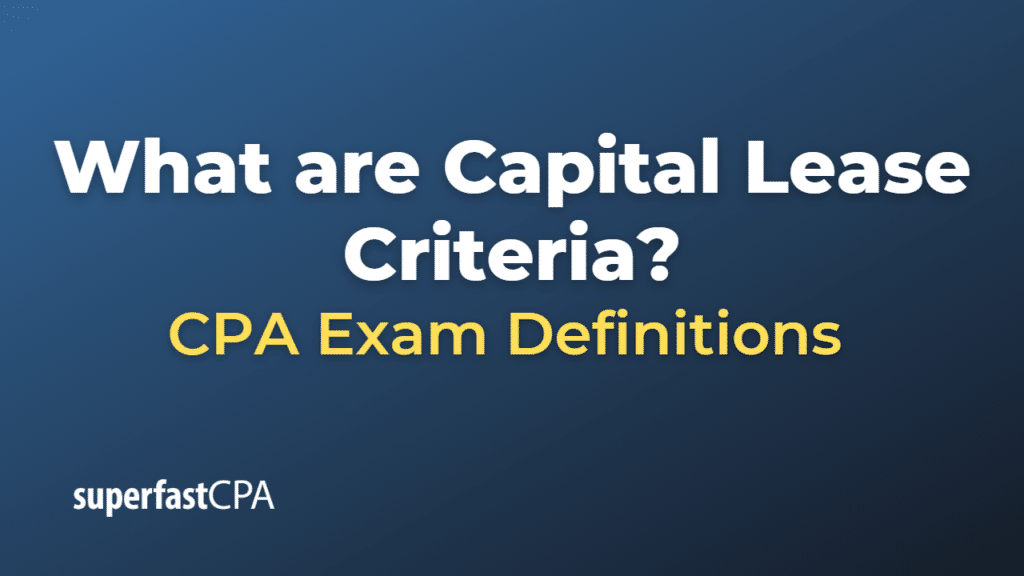Capital Lease Criteria
Capital lease criteria are the specific conditions used to determine if a lease should be classified as a capital lease (also known as a finance lease) or an operating lease. The classification depends on whether the lease agreement effectively transfers the risks and rewards of ownership of the leased asset from the lessor to the lessee. Different accounting standards, such as U.S. Generally Accepted Accounting Principles (U.S. GAAP) and International Financial Reporting Standards (IFRS), have slightly different criteria for capital lease classification.
Under U.S. GAAP, a lease is considered a capital lease if it meets any one of the following four criteria:
- Ownership transfer: The lease agreement includes a provision for the transfer of ownership of the leased asset to the lessee by the end of the lease term.
- Bargain purchase option: The lease agreement contains a bargain purchase option, allowing the lessee to buy the leased asset at a significantly discounted price at the end of the lease term.
- Lease term: The lease term is equal to or greater than 75% of the estimated economic life of the leased asset.
- Present value of lease payments: The present value of the minimum lease payments is equal to or greater than 90% of the fair market value of the leased asset at the inception of the lease.
If a lease meets any of these four criteria, it is classified as a capital lease and accounted for accordingly. Otherwise, it is considered an operating lease.
Under IFRS, the capital lease criteria are less prescriptive and more focused on the substance of the transaction. A lease is considered a finance lease under IFRS if it meets one or more of the following criteria:
- Ownership transfer: The lease agreement transfers ownership of the leased asset to the lessee by the end of the lease term.
- Bargain purchase option: The lease agreement contains a bargain purchase option, allowing the lessee to buy the leased asset at a significantly discounted price at the end of the lease term.
- Substantially all risks and rewards: The lease agreement transfers substantially all the risks and rewards of ownership of the leased asset to the lessee.
If a lease meets one or more of these criteria, it is classified as a finance lease under IFRS. Otherwise, it is considered an operating lease. Note that IFRS does not specify quantitative thresholds like U.S. GAAP does, relying instead on a more qualitative assessment of the lease agreement’s substance.
Example of Capital Lease Criteria
Let’s consider a fictional example involving a company called “TechDynamics Inc.” that enters into a lease agreement for a high-tech manufacturing machine.
TechDynamics is a technology company that needs a specialized machine for its manufacturing process. The machine has a fair market value of $300,000 and an estimated economic life of 8 years. TechDynamics enters into a 6-year lease agreement with a lessor for the use of the machine, with annual lease payments of $55,000. The lease agreement does not include any provisions for ownership transfer or bargain purchase options.
Let’s evaluate this lease using U.S. GAAP capital lease criteria:
- Ownership transfer: There is no provision for ownership transfer by the end of the lease term. This criterion is not met.
- Bargain purchase option: There is no bargain purchase option included in the lease agreement. This criterion is not met.
- Lease term: The lease term is 6 years, which is 75% of the estimated economic life of the machine (8 years). This criterion is met.
- Present value of lease payments: Assuming an interest rate of 5%, the present value of the 6 annual lease payments of $55,000 is approximately $266,740, which is 88.9% of the machine’s fair market value ($300,000). This criterion is not met.
Since the lease meets one of the four U.S. GAAP capital lease criteria (the lease term), TechDynamics would classify this lease as a capital lease and account for it accordingly.
Under IFRS, the assessment would be more qualitative. In this case, the lease term is 75% of the estimated economic life of the machine, suggesting that the lessee assumes a significant portion of the risks and rewards associated with the asset. Based on this factor, TechDynamics could classify the lease as a finance lease under IFRS as well.
This example demonstrates how capital lease criteria can be used to determine the appropriate classification of a lease agreement and the corresponding accounting treatment for the lessee.













